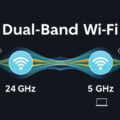In the intricate world of wireless networking, one of the greatest challenges is managing congestion on Wi-Fi channels. Whether you’re streaming your favorite series, working from home, or gaming online, the performance of your Wi-Fi network hinges on the channels you choose for connectivity. This article provides insights and actionable strategies to help you select less congested channels, ensuring optimal network performance.

Understanding Wi-Fi Channels and Congestion
Wi-Fi operates primarily on two frequency bands: 2.4 GHz and 5 GHz. Each of these bands is divided into channels which can be affected by a variety of factors including interference from other networks, electronic devices, and physical obstructions like walls. As more devices connect to Wi-Fi networks, the likelihood of congestion increases, leading to slow speeds and unreliable connections.
Bandwidth and Channel Width
Both 2.4 GHz and 5 GHz bands have varying characteristics:
-
2.4 GHz Band: This band is wider and has fewer channels that don’t overlap — specifically channels 1, 6, and 11 are recommended as they prevent interference. However, this band experiences high congestion due to its popularity, making it less ideal for high-bandwidth activities like video streaming or gaming.
-
5 GHz Band: Offering a wider array of channels that don’t overlap, the 5 GHz band typically accommodates higher traffic with less interference, but its range is shorter. Modern routers may utilize features like channel bonding, which allows for better speed and bandwidth, although care must be taken to avoid overlapping channels with neighboring networks.
Tips for Selecting Less Congested Channels
-
Use a Wi-Fi Analyzer: To find which channels are least congested, use a Wi-Fi analyzer app. These applications can scan the neighborhood and provide insight into which channels are in use and their respective strengths. You can download these apps on various devices, including smartphones and laptops.
-
Optimal Channel Selection:
- For 2.4 GHz, always choose among channels 1, 6, or 11 and select the least utilized of the three. If you’re in Europe, channels 12 and 13 can also be considered but measure their usage carefully given potential interference with channel 11.
- For 5 GHz, choose lower channels like 36, 40, 44, or 48, or upper channels like 149, 153, 157, and 161. Being aware of DFS (Dynamic Frequency Selection) channels is crucial as they may cause connectivity issues when radar is detected.
-
Adjust Channel Width: Sometimes, channel width impacts congestion. For 2.4 GHz, a width of 20 MHz is often more stable, while for 5 GHz, setting the width to 40 MHz provides a balance of speed and reliability. Wider channels can offer better speeds but may also attract interference from surrounding devices and networks.
-
Regularly Monitor Performance: Changes in your environment can significantly affect network performance. Regularly test and adjust your channels based on current conditions. This is particularly pertinent in high-density areas such as apartment complexes, where neighbors’ usage can fluctuate heavily.
-
Consider Advanced Options: With technologies like Wi-Fi 6 and Wi-Fi 6E, exploring the 6 GHz band can be beneficial. Although still emerging, this band is expected to provide optimal performance with minimal congestion due to its availability of 59 channels.
Conclusion
Selecting less congested channels is crucial for optimizing the performance of your wireless network. By leveraging Wi-Fi analyzer tools, understanding channel dynamics, and regularly adjusting your settings, you can significantly reduce interference and enhance your overall internet experience. Stay proactive in your approach to network management and enjoy a seamless home or office connectivity experience.



